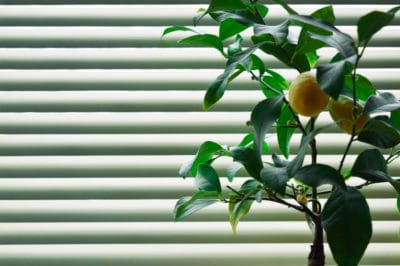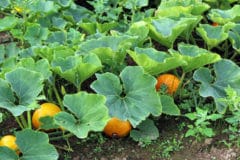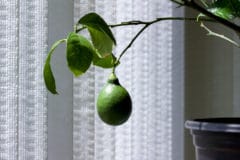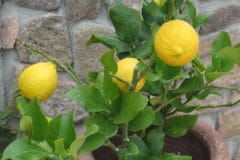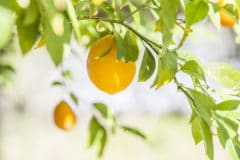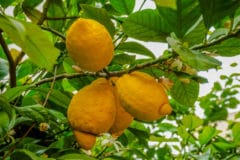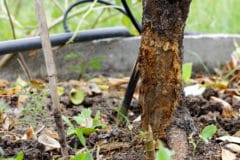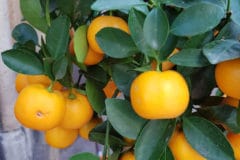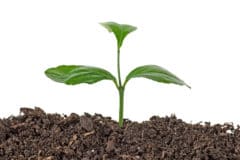Choosing the Right Tree
With regular pruning, most varieties of lemon trees will remain small enough to grow in containers. But choosing a dwarf tree spares you frequent pruning and repotting. The trees proven to perform well indoors include:
- ‘Meyer’: A shrubby tree reaching 8 to 10 feet high and up to 12 feet wide when planted outdoors in USDA zones 9 through 11. Its thin-skinned fruit is noticeably sweeter than that of other varieties.
- “Eureka Variegated Pink” (aka the pink lemonade lemon): Reaching from 12 to 15 feet high when grafted onto dwarfing rootstock, this variety has variegated, green-and-ivory leaves and pink pulp loaded with very acidic pale-pink juice
- ‘Eureka’: An open, spreading tree reaching from 8 to 10 feet tall when grafted onto dwarfing root stock. It produces oblong, golden-yellow fruit with soft, juicy acidic pulp.
‘Eureka’ and the pink lemonade lemon grow outdoors in USDA zones 9 and 10.
A Suitable Container: Looks Aren’t Everything
Your indoor lemon tree’s container should do more than enhance your décor. Look for one of lightweight, moisture-retentive plastic or polypropylene. And avoid black, no matter how appealing you find it. It absorbs and retains the sun’s heat, so any lemon tree in a black pot faces roasted roots.
Expert gardener’s tip: Besides being too heavy to move easily, porous wood or unglazed ceramic and clay containers require more frequent watering than non-porous ones.
Pot Size
Your lemon tree’s roots need room to grow, so choose a pot one size larger than its nursery container and upsize as needed every four to five years.
Drainage Holes
No matter where they grow, lemon trees need good drainage. Look for a container with multiple drainage holes that let excess water out and root-aerating oxygen in. If the plastic pot you really want has one central drainage hole, cutting four or five others around the circumference of the base is a good idea.
Things you’ll need:
- Sharp paring knife
- Measuring tape
- Contrasting marker
- Invert the pot.
- Measure and mark four or five equally spaced points just inside the edge of the base.
- Use the tip of the paring knife to make a small horizontal cut at one of the points.
- Make two more cuts to form a triangle with the horizontal cut at its base.
- Repeat for each drainage hole.
That’s it!
Pot Accessories
Must-have accessories for your indoor lemon tree are a plastic drainage saucer and a plant caddy. The caddy can wait until the tree is too heavy for you to move on your own. A caster-equipped planter would also work.
Potting Your Tree
Don’t skimp by planting your tree in ordinary garden soil. Use a commercial potting mix formulated for citrus trees, or better yet, make your own with equal parts of sand, peat moss and bark. Replace the mix with a fresh batch each time you repot the tree.
Set your pot in its saucer (on your plant caddy, if you have one). Add a 5-inch layer of moistened potting soil. Remove your tree carefully from its nursery container, gently untangle its roots and center it in the pot. Gradually add more moist potting mix, tamping frequently to eliminate air pockets.
Cover the roots with potting mix. Stop when you’re within 1 or 2 inches of the rim so you can water the tree without the pot overflowing. When you’re done, the small scar where the tree was grafted to its rootstock should be 4 to 8 inches above the mix.
Water the tree well, let the pot drain, empty the saucer and water again.
Ongoing Care
Light, humidity, temperature. water, fertilizer and pest control all play a role in your indoor lemon tree’s health.
Humidity
The humidity of most indoor environments averages between 15 and 20 percent. Lemon trees need humidity two to three times that. If yours is still small enough, balance it on a brick set in a plastic tray of wet pebbles. Air flowing over the drainage holes will keep the roots dry as the humidity rises.
While a lemon tree will grow indoors year round, it really benefits from spending the summer outdoors when the temperatures are consistently above 55°F (12.7°C). If that’s not possible, open the windows frequently to boost its air flow.
Temperature
Your tree will perform best at 65°F (18 °C), but it can adapt to temperatures between 55°and 85°F (12.7°and 29.4°C) as long as the change isn’t sudden. Keep it away from heating vents and cold drafts.
Watering
When top of the potting mix feels and looks very dry, water slowly until the pot feels heavy and water runs from the drainage holes. Soggy roots are much more dangerous to your tree that thirsty ones.
If a wilted tree recovers within a day after watering, it was too dry. If it has yellowing, cupped leaves, it’s probably too wet. Start making a note of each time you water and tweak your schedule accordingly.
Fertilizing
An organic, slow-release granular fertilizer satisfies your tree’s nutritional needs without burning its roots. Look for a one containing 2 or 3 times as much nitrogen (N) as potassium and phosphorous (P and K), such as a 2-1-1 or 6-3-3 formula. Choose one enhanced with supplemented with the trace minerals iron, manganese, zinc and calcium.
Expert gardener’s tip: Fertilizers come in different strengths. Always follow the labels instructions on how much to use and how often to apply the one you use.
Pest Control
Indoor lemon trees attract several leaf-feeding pests, including:
- Aphids
- Mealybugs
- Mites
- Scale insects
- Whiteflies
Depending on the pests involved, your tree may have chewed, curling, browning or yellow-spotted leaves. Mealybug infestations resemble cottony clumps, and scale insects look like tiny barnacles. Aphids and whiteflies cover the foliage with sticky, clear waste called honeydew.
Treatment
Unchecked pest problems lead to slow growth and minimal flower and fruit production. Fortunately, all these pests can be controlled with organic insecticidal soap. Simply spray it on the leaves and branches to the point of runoff. Repeat every three days until the bugs are gone.
Expert gardener’s tip: To make your own insecticidal soap, mix 2 tablespoons (30ml) of plant-based, liquid dish soap in 1 gallon (3.78 liters) of soft water. Hard water creates soap scum that stops the spray from working correctly.
Pollination
With the right care, your indoor lemon tree should begin blooming in about two or three years. Meyer lemons bloom in spring and fall! But without bees to pollinate them, they won’t bear fruit unless you intervene.
Hand Pollination
To hand pollinate, simply use a small, soft-bristled artist’s brush to transfer the golden-yellow pollen from a flower’s stringy anthers to the sticky stigma located at the end of its pistil. That’s the long central filament resembling an upside-down mushroom. Repeat for all the flowers.
Repotting Your Tree
A thriving lemon tree outgrows its pot every four to five years. At that point, move it to a pot one size larger, until you have it in one measuring 24 inches deep and wide. After that, sustain it with plenty of fertilizer. Always repot in spring.
To repot your tree:
- Moisten a batch of fresh citrus potting mix.
- Slide your tree gently from its container and trim any roots encircling the rootball.
- Center the tree in the new pot and fill in around the rootball with the fresh mix
- Barely cover the surface of the rootball, so that when you scrape the surface of the potting mix the feeder roots are visible.
- Top the potting mix with the recommended amount of organic, granular fertilizer for the size of pot you’re using.
- Water the tree. If the potting mix settles enough to expose the rootball, add more.
Expert gardener’s tip: To give your newly repotted lemon tree a professional finish — and keep its roots cool and moist — cover the potting mix with a 2-inch layer of organic mulch, such as pine bark or wood chips.
